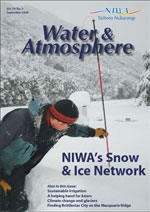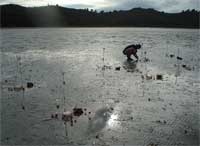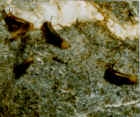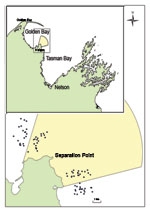PDF of this article (255 KB)





Sean Handley and Russell Cole have seized a rare opportunity to work with an undisturbed underwater landscape.
When it comes to studying New Zealand’s most common of type of seabed – soft-sediment habitats – marine ecologists and fisheries scientists have a problem. So much of the habitat has been changed by the physical effects associated with commercial fishing (for example, from trawling and scallop dredging), there are very few unimpacted or ‘control’ sites left to study. This makes it difficult to work out how these habitats are supposed to function, and to tease out the real effects of disturbance from fishing and land-based activities. Now we believe we have found a window to the past in an area that was closed to fisheries almost 30 years ago.
Closed for business
In December 1980, the Ministry of Fisheries closed the Separation Point protected area to all forms of power fishing in order to protect bryozoan beds and associated juvenile fish. Separation Point lies northwest of Nelson on the northern coast of the South Island, and separates Tasman Bay from Golden Bay. The area had abundant bryozoans (invertebrates commonly known as ‘moss animals’ or ‘lace corals’), which were thought to provide habitat for juvenile finfish. Many bryozoan species are fragile and readily damaged by physical contact, and fishing methods such as trawling or dredging would be expected to rapidly crush bryozoan colonies. The fisheries closure was put in place because of concern that damaging the habitat might reduce recruitment of fish such as snapper or tarakihi into the fishery.
Even before its closure, Separation Point had not seen much disturbance to the seabed. It was not trawled before 1972; from then until 1980 there was some pair trawling, but the gear was apparently ‘flown’ above the bottom to minimise the bycatch of bryozoans and sponges, which would quickly fill and rip the nets.
Why are we so excited about this site? We think Separation Point can give us a useful view of what some of New Zealand’s soft-sediment habitats were like before human impacts andfishing. Even more importantly, it could also be a valuable laboratory for evaluating techniques that have been used overseas to determine the true effects of bottom disturbance from the likes of trawling and dredging.
What have we learned so far?
We’ve begun to study the area using sidescan sonar and grab samples to compare the seafloor inside and outside of the protected zone. It’s clear from our findings that the fishing industry has laudably complied with the fishing closure. We’ve also found surprising differences in the seafloor texture and composition inside and outside the area at the scale of kilometres.
Grab samples of the sediments from inside the closure area are very coarse, full of shell, and poorly sorted; in contrast, the samples from adjacent fished areas comprise almost entirely soft muds, nearly devoid of shell material and surface-dwelling organisms. Our results so far show there are differences in the number and type of organisms inside and outside the closure area, similar to fisheries-impact studies at other locations in New Zealand and overseas.
Similar studies elsewhere
Previous fishing-impact studies from New Zealand and overseas have investigated the effects of fishing using two approaches:
- targeted research into the effects of dredging, trawling, andother forms of fishing, and
- experiments where fishing has been stopped in some areas, such as marine reserves or temporarily closed areas.
In most of those studies, the emphasis has been on the effects of fishing on target organisms, but wider ecosystem effects of fisheries closures have also been documented.
Perhaps the best-known New Zealand example of linkages between species protected from fishing comes from the Cape Rodney–Okakari Point Marine Reserve – better known as Goat Island. There, in the late 1990s, protection of snapper and crayfish resulted in the subsequent loss of barrens habitat dominated by sea urchins and its replacement by kelp forest.
Our Separation Point study aims to determine the effectiveness of this closure area to all benthic (seabed) organisms, which has relevance to the wider ecosystem through the food chain. To do this, we will calculate indices of biomass and productivity from organisms we have collected in the contrasting sediment samples from fished and unfished areas.
A valuable laboratory
Intuitively, we expect that highly productive areas should produce and support more biological material per unit area; this includes organisms– like fish – of direct interest to humans. We know fishing methods that impact the seabed reduce habitat structure and prevent larger animals from accumulating, but we can’t confidently extrapolate these impacts at the level of the individual organism to the entire community without adequate control sites. This highlights the importance of closure areas like Separation Point, marine reserves, and the like: they are essential not only for the individual animals and plants they protect, but are also useful as laboratories to determine roles and contribution of non-target species to the ecosystem, and how ecosystems tick when viewed as a whole.
These results are the initial findings of a two-year study; next year we will move on to more detailed investigations of effects on community processes. Watch this space for a report on future findings, which we anticipate will lead to examining the ecosystem consequences of disturbances by commercial fisheries.
Window to the past
- Scientists are studying a rare example of shallow seabed that hasn’t been commercially fished for 30 years.
- They are comparing the seabed and organisms inside andoutside of the undisturbed area to measure the effects of activities such as dredging and trawling.
- The area is also useful as a laboratory for studying whole ecosystems.
Further reading
Babcock, R.C.; Kelly, S.; Shears, N.T.; Walker, J.W.; Willis, T.J. (1999). Changes in community structure in temperate marine reserves. Marine Ecology Progress Series 189: 125–134.
Bradstock, M.; Gordon, D.P. (1983). Coral-like bryozoan growths in Tasman Bay, and their protection to conserve commercial fish stocks. New Zealand Journal of Marine and Freshwater Research 17(2): 159–163.
Grange, K.R.; Tovey, A.; Hill, A.F. (2003). The spatial extent and nature of the bryozoan communities at Separation Point, Tasman Bay. New Zealand Ministry of Fisheries. Marine Biodiversity Biosecurity Report No. 4. 22 p.
Lohrer, A.M.; Thrush, S.F.; Gibbs, M.M. (2004) Bioturbators enhance ecosystem function through complex biogeochemical interactions. Nature 431: 1092–1095.
Thrush, S.F.; Hewitt, J.E.; Cummings, V.J.; Dayton, P.K.; Cryer, M.; Turner, S.J.; Funnell, G.A.; Budd, R.G.; Milburn, C.J.; Wilkinson, M.R. (1998). Disturbance of the marine benthic habitat by commercial fishing: impacts at the scale of the fishery. Ecological Applications 8: 866–879.
Dr Sean Handley and Dr Russell Cole study marine ecology and are based at NIWA in Nelson. This research is supported by NIWA capability funding from the Foundation for Research, Science and Technology.
Teachers’ resource for NCEA Achievement Standards or Unit Standards: Biology Level 2 AS90461, Level 3 AS90714 Science Level 2 AS90771, US6352, Level 3 US6355, US21613
